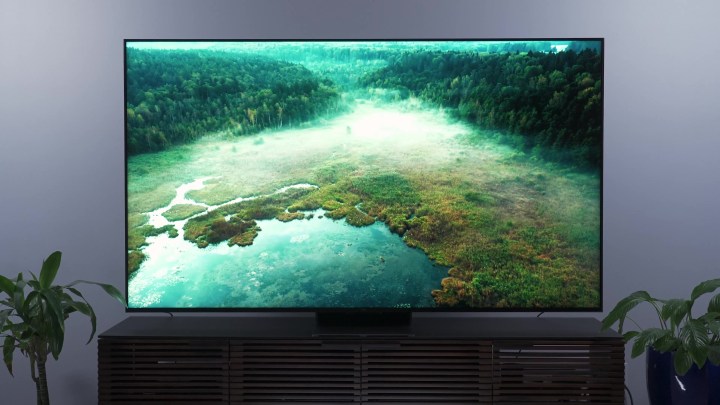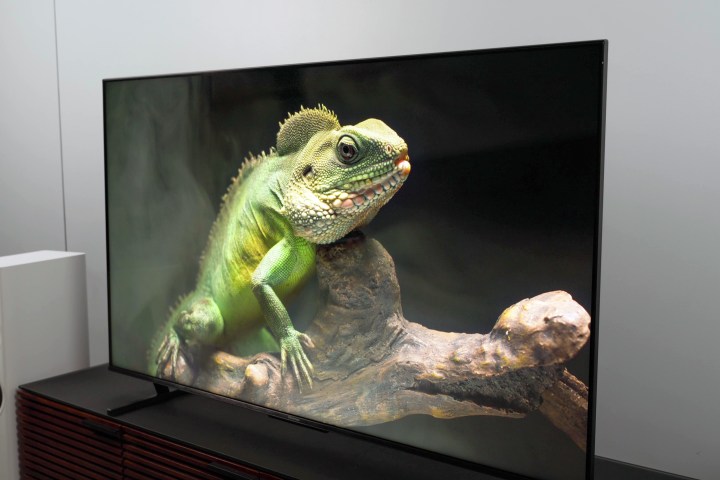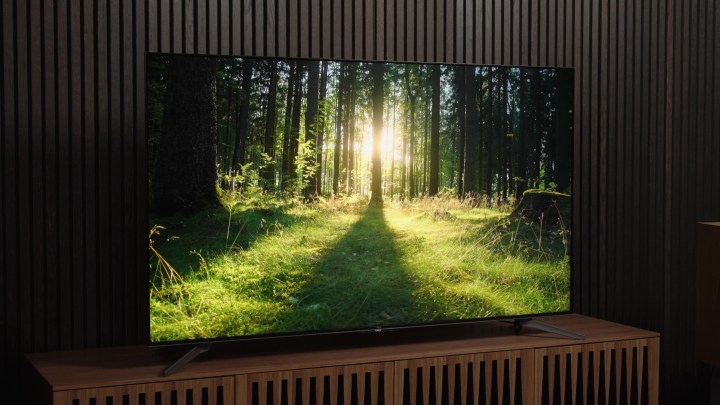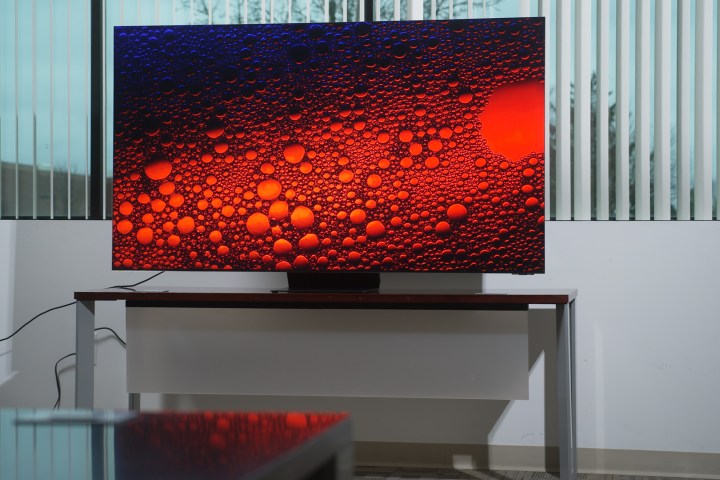








If you're in the market for a new TV, you've probably come across different TV technologies, such as OLED, LED, mini-LED, and QLED. Each of these technologies has its own advantages and price points. QLED TVs, in particular, offer excellent brightness, vibrant colors, and impressive contrast levels, making them a great choice for bright rooms.
Similar to traditional LED-LCD TVs, QLED TVs use LED backlighting along with a layer of quantum dots. When these nanocrystals are activated, they provide enhanced color saturation and increased brightness, resulting in stunning picture quality.
QLED TVs are manufactured by several companies including Samsung, Sony, TCL, and Hisense. While the newer 2024 QLED models are hitting the market, such as the impressive Hisense U8N with its bright display and rich colors, it might be wise to wait for the prices to drop before making a purchase. In the meantime, last year's models are still excellent and are available at attractive prices. Here are some of the best QLED TVs to consider buying in 2024.

Samsung QN90C Neo QLED
The best overall QLED TV
- Class-leading HDR performance
- Excellent black levels, backlight control
- Outstanding color performance
- Powerful processing
- Premium design and build
- Frustrating Smart TV OS
- Lofty price
It’s hard not to love a Samsung TV. Over the last decade or so, the manufacturer has consistently delivered one amazing set after another, and has been producing some top-notch QLEDS for several years now, and this year's crop should prove to be no different.
Until we get our hands on the 2024s for ourselves, we'll still sing the praises of the 2023 Samsung QN90C. Available in sizes ranging from 43 to 85 inches, the QN90C is going to be the best QLED for most folks; although some may be interested in taking things a step further with the flagship performance of the Samsung S95C QD-OLED.
As for those of us who choose to remain with a more traditional QLED, the QN90C has it all. We’re talking near-impeccable HDR performance, chart-topping peak brightness levels, terrific reflection handling, and some of the best gaming features you’ll find. Many of these features are further enriched by Samsung’s Neural Quantum Processor 4K, which optimizes each and every source to give you as much picture detail as possible, whether you’re watching brand-new Netflix 4K HDR releases or your vintage DVD collection.
When it comes to contrast, QLED TVs are also getting better at acting more like OLEDs, which bodes well for those of us who want our movies and TV shows to be packed with rich colors and amazing black levels. The QN90C is an LED-powered TV, and we did notice a bit of light blooming during darker scenes, but that’s a small grievance about an otherwise remarkable picture.


Sony Bravia X93L mini-LED
The best not-quite QLED alternative
- Excellent motion resolution
- Stellar color accuracy
- Bright, punchy HDR performance
- Solid black levels
- Some backlight blooming/halo
- Poor off-angle performance
While Sony doesn't claim to use quantum dots (it call its tech Triluminos Pro) and doesn't market its TVs as QLEDs, they compete right alongside the TVs on this list that are marketed as QLED. So, if you're considering a "QLED" TV based on the idea that they are top-tier LED/LCD TV performers, then you should also be considering this Sony option, never mind that it doesn't have QLED printed on the box.
With that out of the way, we give you the Sony Bravia X93L mini-LED, a 2023 TV that picks up where last year's excellent flagship Sony X95K mini-LED TV left off, but for a much better price. In fact, the X93L is identical to the X95K but with a handful of software improvements, including better eco settings management, new black level adjustments for better fine-tuning of darker scenes (if you're a Game of Thrones fan), and a new gaming dashboard that lets you switch between 60Hx and 120Hz VRR. It's bright (at 1,800 peak nits), has beautiful color reproduction, supports all the HDR contrasty things you need (HDR10, HLG, and Dolby Vision), and is excellent for gamers, too, with VRR, auto low latency mode, and HDMI 2.1 support.
If you're a fan of Sony soundbars, too, you can take advantage of the X93L's ability to sync the TV's speakers with select soundbars to help with clearer dialog and immersion. It's also Dolby Atmos capable. The X93L is a new spin on one of Sony's best TVs for 2023, but without the premium "Sony tax."


TCL QM8 QLED 4K mini-LED
One of the brightest TVs we've ever seen
- Stunning HDR performance
- Class-leading brightness
- Excellent black levels
- Virtually no detectable blooming
- Very good color saturation/brightness
- Some motion artifacts
TCL is at it again with its lineup of mini-LED QLED TVs that continue to prove that you can have high-end features and quality at prices that are way more reasonable than the marquee TV brands. And the TCL QM8 is literally the brand's shining example ... blindingly shiny with peak brightness levels of 2,500 nits in our tests, making it one of the brightest TVs we've ever seen. Our reviewer was so impressed with the QM8, in fact, that he praised it as his "go-to TV recommendation for probably 90% of people this year."
In-line with QLED's ability to deliver bright images that are great for those setting up their TV in a light-drenched room, the MQ8 also has it where it counts in the contrast area, too, with support for Dolby Vision, HDR10, HRD10+, and HLG, and excellent local dimming that also make it a good performer in darker rooms with decent black levels. Are they as inky as OLED? No, but not much is, and with OLED still costing a premium, it's getting harder and harder to make a viable case for spending the extra cash. The QM8's mini-LED technology delivers excellent color accuracy, too, with 97% coverage of DCI-P3 and about 76% of BT.2020 color gamuts.
The TCL QM8 is a Google TV-based TV, which makes for easy setup and use as well as access to all the streaming services and apps you could ever want via the Google Play Store, plus it's got Chromecast built-in for easy mirroring and casting from your devices.
With a 120Hz refresh rate, fast-action movies are smooth, and gamers will appreciate the TV's support for variable refresh rate (VRR) and Game Accelerator that boosts things up to 240Hz and AMD FreeSync Pro for even smoother gameplay.
The TCL QM8 also features a built-in subwoofer for bigger bass sound, but you're still probably going to want an external soundbar. Available in 65-, 75-, 85-, and 98-inch sizes, the TCL QM8 ranges in price from $1,200 to $10,000.


Hisense U8N ULED TV
Hisense's beautiful and bright QLED for 2024
- Intense brightness
- Deep blacks/contrast
- Vibrant, accurate color
- Great sound
- Overly bright HDR
- Poor off-angle viewing
Hisense's U8 QLED TV for 2024 is the U8N, and it's a diamond in the rough just like its predecessor, the U8K (also on this list). Impossibly bright, sharp, and colorful for the price has been Hisense's (and TCL's for that matter) calling card for years now, making them attractive QLEDs for the value-conscious. They range in size from 55 to 100 inches and in price from around $1,000 to $5,000.
Like its predecessor, the Hisense U8N's picture is crazily close to that of an OLED. It's technically considered a mini-LED backlit, quantum-dot-infused LCD TV that Hisense calls ULED, but it competes directly with QLED, which is why it's on this list. Thousands of local dimming zones make for some excellent peak brightness levels as well as some deep, inky blacks. Plus, the quantum dots make for some vivid and accurate colors.
All the best picture support features are here too, including HDR 10, HDR10+, HLG, and Dolby Vision, and for gamers it's also got a refresh rate of 144Hz and features variable refresh rate (VRR) and is FreeSync Pro certified. Our reviewer Caleb Denison loved the picture quality on the TV, praising its brightness and backlight control as being close to the LG G4 OLED, which is high praise.
The U8N runs on the Google TV operating system, so you have access to all your streaming services and other apps form the Play Store. Google Assistant, YouTube, and YouTube TV are pretty well weaved into the TV, for those who like those sorts of things.
Denison's final word on the Hisense U8N: "It’s freaking awesome to behold. It’s easily one of the best buys of 2024. Maybe even the best buy of the year."


Hisense U8K ULED TV
Unbeatable brightness for an unbeatable price
- Excellent brightness
- Vivid HDR colors
- Very good backlight control
- Excellent contrast
- Great for gaming
- Some color anomalies
- Scattered software bugs
We can’t stop talking about Hisense TVs. When Hisense models first started hitting U.S. shelves, they were decent TVs, but they were certainly aimed at a more price-conscious shopper, with cost valued more than performance. Fast-forward to today, and Hisense has carved out quite the name for itself -- and not just because of how much you won’t spend on a model like the U8K.
This is one mean QLED, folks. In our own testing of the TV, the Hisense U8K rocked the house when it came to peak brightness levels, delivering readings around 2,000 nits when viewing HDR content. Tech talk aside, this means that the U8K can get insanely bright, and without colors becoming oversaturated. That’s the biggest feat, really. Yes, most QLEDs can get very bright, but this tends to interfere with overall color accuracy and contrast. That’s just not the case with the U8K.
Available in 55-, 65-, and 75-inch sizes, the Hisense U8K tops out at 4K/120Hz on its two full-bandwidth HDMI inputs, and also includes Hisense’s Game Mode Pro for those of us hooking up a next-gen console or PC to the TV. And as a little bonus, those two HDMI 2.1 ports will actually push 4K at 144Hz when compatible PC gear is wired up.
The Hisense U8K’s price is a massive calling card, no doubt, but if you’re looking for a hard-hitting QLED that goes above and beyond the “cost-friendly” slabel, do allow Hisense’s flagship model to blow your mind.


TCL Q7 QLED
Great for gaming
- High brightness
- Great contrast
- Vivid color
- Great for gaming
- White balance is just bad
- Color is technically inaccurate
- Inconsistent picture quality from streaming apps
We’ve been very impressed by TCL’s Mini LED models over the last few years, so it’s no surprise that the brand gets more than one mention in our roundup. Sitting one rung below the QM8, the TCL Q7 is another awesome QLED that competes with models like the Hisense U7K and the Sony X90L. We tested the 65-inch version ourselves (it’s also available in 55-, 75-, and 85-inch sizes), and were taken aback by the Q7’s high brightness output and vivid colors.
Now as far as nit metrics go, the TCL Q7 is a bit on the lackluster side Not only did it score some so-so peak brightness readings (around 1,100 nits) with HDR playback, but the meh results found their way into SDR content too (about 700 nits for peak brightness). Compared to TVs like the Hisense U8K, the Q7 just doesn’t touch the kind of QLED brightness of some of its competitors, but that doesn’t mean there isn’t plenty to love about it.
Two of the Q7’s four HDMI inputs are full-bandwidth 2.1 ports that support 4K at up to 120Hz. It also runs the latest version of Google TV for all your Netflix and Prime Video streaming needs. Plus, you’ll be able to use Google Assistant to search for media and control your smart home devices, and there’s also AirPlay and HomeKit support.
In a way, we love the TCL Q7 because it’s not a perfect QLED. But what it does well, it tends to do very well, and the price just can’t be beat.


Samsung QN900C Neo QLED TV
The best 8K QLED
- Delivers up to 8K resolution
- Excellent local dimming capabilities
- Intuitive smart TV platform
- Expensive
- Not a lot of 8K content out there
Many consumer tech companies put the cart before the horse, and the world of TVs may be one of the biggest offenders when it comes to horse-less transportation. In the case of a TV like the Samsung QN900C, our equestrian analogy is best represented by a hardware versus software comparison. Quite simply, the QN900C is an amazing 8K TV, but we’re still living in a world that is primarily dominated by 4K and 1080p content.
Fortunately, Samsung’s next-gen QLED has some fantastic picture processing tech under its hood. The QN900C is outfitted with Samsung’s Quantum Matrix Pro, which itself is powered by mini-LED lighting. Translation, please? You got it! Matrix Pro is Samsung’s fancy-pants terminology for local dimming zones (a small block of LED lights), and because the QN900C uses mini LEDs, the QLED has a lot of control zones. At the end of the day, this means you can expect the QN900C to deliver excellent peak brightness and color brightness to the parts of the panel that require said brightness, while the rest of the screen is enshrouded in darkness (that’s a good thing).
And because this is an 8K TV, the QN900C will upscale whatever 4K or regular high-def HDR and SDR sources you feed it. Of course, you won’t be looking at a true 8K image, but it’ll be dang close! This is also an Infinity One Samsung QLED, which means the chassis is extremely thin and there’s essentially no physical frame to speak of. So, when it comes time to plug in your components, you’ll be doing so with the TV’s external One Connect box (because there’s no HDMI ports on the TV itself).
If you’re into future-proofing your consumer tech, the Samsung QN900C is an 8K TV that will rule your home theater setup for years to come.


Amazon Fire TV Omni QLED
The best budget QLED TV
- Excellent Fire TV experience
- Great smart home hub
- Adequate picture performance
- Fun features
- Lacks HDR punch
- Price-to-picture performance ratio is off
Amazon has been making its own TVs for a few years now, and while these models definitely err toward the more “budget-friendly” side of the price and quality spectrums, we’ll admit that we were pretty impressed by the Amazon Fire TV Omni QLED series. Available in 43-, 55-, 65-, and 75-inch sizes, the Omni QLED delivers a pretty great picture. Now, it’s not the touting the most amazing specs and features in town, and the fact that the Omni QLED only tops out at 60Hz is a bit disappointing, but where the Omni QLED truly shines is in its Fire TV smart UI.
From the ground up, this is a TV built around Amazon’s larger smart home ecosystem, to the point where the Omni QLED has Alexa built right into it. This means you can fire off voice commands right from your living room couch, as well as control everything from smart lights and locks to web-connected security systems. You’ll even be able to see a live view from any compatible smart cameras right on your TV screen. And when the Omni QLED is powered down, you’ll be able to use the Fire TV Ambient Experience to display artwork and photos.
Other add-ons like Dolby Vision IQ and HDR10+ Adaptive support bring a few more picture perks to sweeten the deal. Again, the Fire TV Omni QLED may not be the best QLED ever made, but it’s definitely worth adding to our list.

Frequently Asked Questions
The "Q" in QLED stands for quantum dot, a nanoparticle that emits light when energized. Quantum dots can be tuned to emit specific wavelengths of light, so TV makers add green and red quantum dots in a layer over their blue LED backlights, which creates a much purer white light than a single LED backlight can create on its own. With a pure white backlight, the TV's color filters can produce much more accurate colors, leading to significantly better picture quality than regular LED TVs.
UHD stands for ultra-high definition, also known as 4K. It's a description of resolution, or the number of pixels that make up an on-screen image. It can refer to the resolution of a specific piece of content (many streaming services offer movies in UHD) as well as the native resolution of a TV. QLED refers to the kind of display technology a TV uses (see above). QLED TVs come in various native resolutions, from HD to 8K, including UHD.
It depends. Right now, QLED TVs are capable of getting brighter than OLED TVs, which deliver better black levels and contrast. We feel that OLED TVs still produce a better overall picture quality, but if your viewing area is especially bright, or if you want a really big screen, QLED models might be a better choice for you.
Once again, it depends on your particular situation. For instance, if you want a TV for your patio, where it will experience partial or full sun, an OLED TV simply won't get bright enough to compete with all that daylight, and a QLED TV is definitely superior. On the other hand, if you can darken your media room whenever you want, an OLED TV will still deliver the deepest blacks and highest contrast.
Finding the right QLED TV for you is all about balancing size, picture quality, features, and price. First, figure out your budget, then prioritize the rest of your list. If getting the biggest TV for your money is the top priority, you'll be able to find 75-inch and larger models from brands like TCL, Vizio, Hisense, and LG that are still quite affordable. If picture quality matters more – especially when viewing HDR material – you should choose a model with a very high peak brightness. If gaming is a top consideration, make sure you find a model that's equipped with VRR, ALLM, and 4K at 120Hz for the best possible experience.
Samsung has two flagship QLED models depending on whether you want 8K resolution. The QN900C is the company's top 8K model, and the QN90C is its top 4K model.
Yes, but picking the right model is key. You'll want to look for a TV that has the latest HDMI 2.1 features, like VRR, ALLM, and 4K at 120Hz. Another feature that gamers will appreciate is support for AMD's FreeSync or Nvidia's G-Sync, which are two proprietary VRR technologies used by game consoles like the Xbox Series X and many gaming PCs.
No. Burn-in is a permanent form of image retention caused by leaving the same image on a TV for many hours at a time. In OLED TVs, this can cause individual pixels to age prematurely, leaving the "shadow" of some parts of the image on screen even after the image has changed. Because QLED TVs use a backlight for their brightness, their pixels aren't susceptible to this kind of uneven aging.
Theoretically, a QLED TV will outlast an OLED TV, at least in terms of maximum brightness, because OLED pixels lose their ability to produce brightness at a faster rate than a QLED TV's backlight. But you would likely have to keep your TV on for eight hours a day, seven days a week, for many, many years before this difference became noticeable. That said, a QLED TV should last a decade or more as long as none of its individual components fail -- something that can be hard to predict even for the best TVs.
QLED prices, much like OLED prices, are dropping all the time. A few years ago, you'd need to spend well over $2,000 for a 65-inch QLED TV. Today, you can find them for less than half that price.
Definitely. If you have a choice between a standard LED TV and a QLED TV, the QLED model will deliver brighter, more accurate colors, which should yield a better image overall. And as QLED TVs become the norm for non-OLED models, you won't have to pay much of a price premium to get one.




